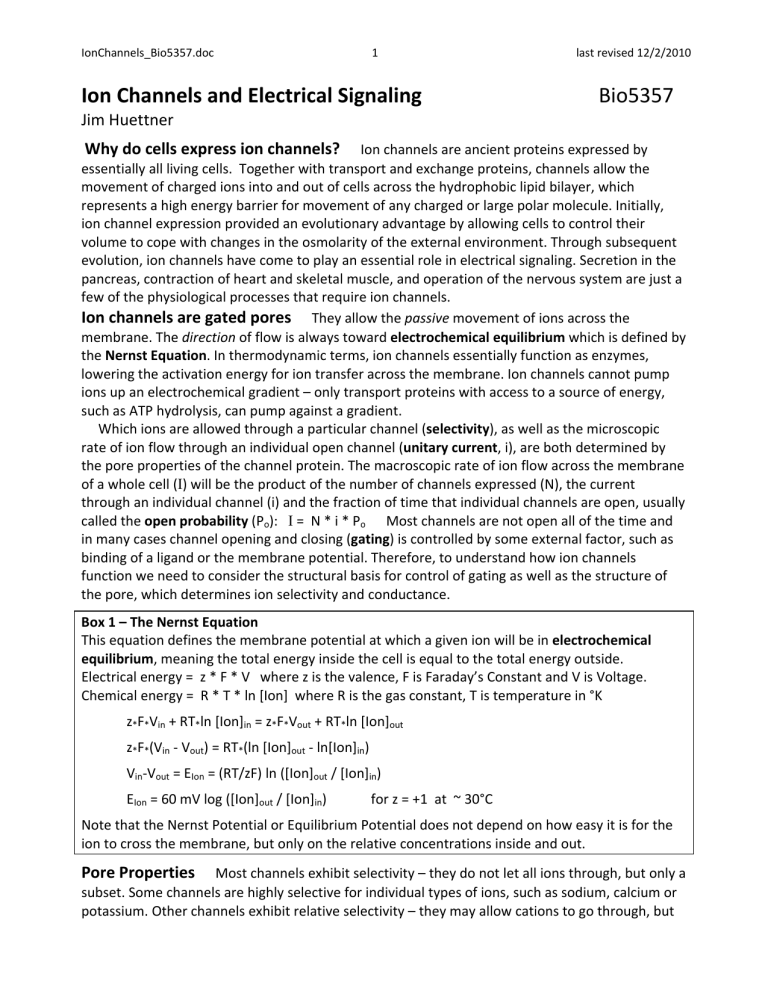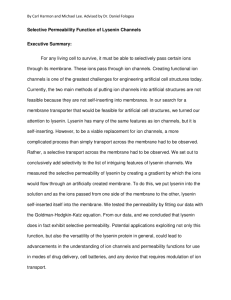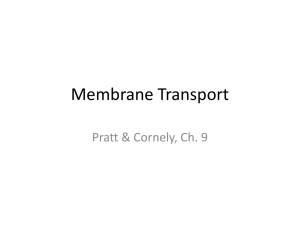Ion Channels and Electrical Signaling Bio5357 Jim Huettner Why do cells express ion channels?

IonChannels_Bio5357.doc
1 last revised 12/2/2010
Ion
Channels
and
Electrical
Signaling
Bio5357
Jim Huettner
Why do cells express ion channels?
Ion channels are ancient proteins expressed by essentially all living cells.
Together with transport and exchange proteins, channels allow the movement of charged ions into and out of cells across the hydrophobic lipid bilayer, which represents a high energy barrier for movement of any charged or large polar molecule.
Initially, ion channel expression provided an evolutionary advantage by allowing cells to control their volume to cope with changes in the osmolarity of the external environment.
Through subsequent evolution, ion channels have come to play an essential role in electrical signaling.
Secretion in the pancreas, contraction of heart and skeletal muscle, and operation of the nervous system are just a few of the physiological processes that require ion channels.
Ion channels are gated pores They allow the passive movement of ions across the membrane.
The direction of flow is always toward electrochemical equilibrium which is defined by the Nernst Equation .
In thermodynamic terms, ion channels essentially function as enzymes, lowering the activation energy for ion transfer across the membrane.
Ion channels cannot pump ions up an electrochemical gradient – only transport proteins with access to a source of energy, such as ATP hydrolysis, can pump against a gradient.
Which ions are allowed through a particular channel ( selectivity ), as well as the microscopic rate of ion flow through an individual open channel ( unitary current , i), are both determined by the pore properties of the channel protein.
The macroscopic rate of ion flow across the membrane of a whole cell ( I ) will be the product of the number of channels expressed (N), the current through an individual channel (i) and the fraction of time that individual channels are open, usually called the open probability (P o
): I = N * i * P o
Most channels are not open all of the time and in many cases channel opening and closing ( gating ) is controlled by some external factor, such as binding of a ligand or the membrane potential.
Therefore, to understand how ion channels function we need to consider the structural basis for control of gating as well as the structure of the pore, which determines ion selectivity and conductance.
Box 1 – The Nernst Equation
This equation defines the membrane potential at which a given ion will be in electrochemical equilibrium , meaning the total energy inside the cell is equal to the total energy outside.
Electrical energy = z * F * V where z is the valence, F is Faraday’s Constant and V is Voltage.
Chemical energy = R * T * ln [Ion] where R is the gas constant, T is temperature in °K
z
*
F
*
V in
+ RT
* ln [Ion] in
= z
*
F
*
V out
+ RT
* ln [Ion] out
z
*
F
*
(V in
‐ V out
) = RT
*
(ln [Ion] out
‐ ln[Ion] in
)
V in
‐ V out
= E
Ion
= (RT/zF) ln ([Ion] out
/ [Ion] in
)
E
Ion
= 60 mV log ([Ion] out
/ [Ion] in
) for z = +1 at ~ 30°C
Note that the Nernst Potential or Equilibrium Potential does not depend on how easy it is for the ion to cross the membrane, but only on the relative concentrations inside and out.
Pore Properties Most channels exhibit selectivity – they do not let all ions through, but only a subset.
Some channels are highly selective for individual types of ions, such as sodium, calcium or potassium.
Other channels exhibit relative selectivity – they may allow cations to go through, but
IonChannels_Bio5357.doc
2 last revised 12/2/2010 exclude anions.
The physical size of the hole formed by the channel protein at its narrowest constriction, as well as the side chains lining the pore, both play important roles in determining selectivity.
Less selective channels typically have larger sized pores, 6 or more Angstroms in diameter at the narrowest point, that allow water (2.8
Angstroms) as well as ions (2 Angstroms and up) to pass through along a polar pathway.
Ions are soluble in water because of electrostatic interactions with the dipolar water molecules.
On the other hand, the nonpolar core of a lipid bilayer is virtually impermeable to ions.
In solution, ions are constantly binding and unbinding with water at rates of around 10
9
per second.
Water molecules make and break bonds with each other about 100 times faster.
Smaller ions, due to a higher charge density, bind water more tightly than do larger ions.
Thus a larger ion, such as potassium with a diameter of 2.66
Angstroms, can shed its waters of hydration more easily than can sodium, with a smaller diameter of 1.9
Angstroms.
Channels can achieve high selectivity by having a pore diameter that is only just wide enough for a dehydrated ion to pass through, and a pore lined with polar groups placed appropriately to compensate for lost waters of hydration, since an ion will not dehydrate spontaneously.
Thus, even though sodium could fit through a potassium ‐ selective channel, the potassium channel does not provide an energetically favorable environment for sodium ions to dehydrate.
Conversely, sodium ‐ selective channels do specifically provide an environment favorable for dehydration of sodium.
Interaction between the ion and these sites within the channel should not be much stronger than binding to water, however, or the ion would dwell within the pore and the flux rate from one side to the other would be slow (i.e.
conductance would be low and unitary current would be small).
Box 2 – Basic Electricity
Ions in solution are charged particles that move.
Charge (Q) is measured in Coulombs.
Movement of charge is Current ( I ), measured in Amps (A).
Voltage (V) measures the energy difference for a charged particle in two different places, or the work required to move from one location to the other.
Ohm’s Law says that movement of charged particles through homogeneous material is proportional to the voltage difference from one end to the other.
Conductance (G), measured in
Siemens (S), is the proportionality factor between current and voltage.
Resistance (R), measured in
Ohms ( Ω ), is the inverse of conductance.
Separation of (+) and ( ‐ ) charges across an insulating barrier produces a potential difference or Voltage.
Capacitance (C), measured in Farads (F), tells how much charge must be separated to give a particular voltage.
Biological membranes have a specific capacitance of 1 µF / cm
2
Current (Amps) = Coulombs / sec Voltage (Volts) = Joules / Coulomb
Ohm’s Law: I = G * V or V = I * R 1 Amp = 1 Volt / 1 Ohm
Capacitance (Farads) = Q / V = Coulombs / Volt
Channel Structure Starting in the 1980’s the first ion channel protein cDNAs were cloned.
In
1998 the first crystal structure of an ion channel was determined by Rod MacKinnon, who won the
2003 Nobel Prize in Chemistry for his work.
Vertebrate genomes include more than 100 genes encoding distinct ion channels, but many of the genes are related and structural commonalities can be recognized.
Figure 1 on the next page shows four different, but related, subunits from a voltage ‐ gated potassium channel, a voltage ‐ gated sodium channel, a voltage ‐ gated calcium channel and the bacterial KcsA channel, which was the first channel crystallized by MacKinnon.
The KcsA subunit has two membrane ‐ spanning alpha ‐ helices and a loop between them that is shown dipping into the membrane, which we now know contributes to the pore of the channel.
IonChannels_Bio5357.doc
3 last revised 12/2/2010
Figure 1.
Membrane topology of several pore ‐ loop superfamily members
Four of these KcsA subunits would combine to form a functional channel as illustrated in Figure 2.
Each of the other subunits in Figure 1 include the helix ‐ pore loop ‐ helix motif of KcsA, preceded by four additional transmembrane helices.
The voltage ‐ gated potassium channel also requires four independent subunits to combine, whereas the sodium and calcium channel subunits include all four pseudo ‐ subunits stitched together into one continuous unit that can form a channel by itself.
Figure 2.
KcsA ribbon diagram Figure 3.
Potassium ion coordination
Segments from two of the four subunits coordinating spheres the size of potassium ions are shown in Figure 3.
Several potassium ions are in the channel at any given moment and this figure illustrates how peptide backbone carbonyl groups appear to substitute for the oxygen atoms in water molecules that would hydrate the ions in solution.
This feature, together with the electrostatic environment within the central cavity, accounts for potassium ion selectivity.
Channel Gating The KcsA crystal structure is likely to be a closed channel.
The structure of a related channel, MethK, in the open state has the transmembrane helices splayed away from the
IonChannels_Bio5357.doc
4 last revised 12/2/2010 central axis of the pore, suggesting that the gate for ion flux is located where the four inner helices come together at the so called bundle crossing.
This interpretation fits well with a variety of data on gating ‐ dependent accessibility of chemical modifiers to residues that line the central cavity.
Other evidence suggests that conformational changes in the pore loop are responsible for shutting the conduction pathway in some cases.
For ligand ‐ gated channels, the conformational change associated with ligand binding must be transmitted through the protein to pry apart the bundle crossing.
In many such proteins the ligand binding domain is located outside of the membrane, either in the cytoplasm for sensing intracellular ligand such as calcium, or on the extracellular side for channels gated by neurotransmitters such as glutamate.
Some of these binding domains have been crystallized as separate soluble pieces, detached from the membrane ‐ spanning channel segment.
Exactly how they operate the channel remains to be worked out.
As the name implies, changes in membrane potential control the gating of voltage ‐ gated channels.
The difference in potential only exists right across the width of the bilayer, so the portion of the channel responsible for sensing voltage must be embedded within the membrane and must be charged.
The diagrams of the three voltage ‐ gated channels in Figure 1 highlight the fourth transmembrane helix, which has several positively charged arginine residues in all of these channels.
Site ‐ directed mutagenesis has shown that neutralization of these charged side chains alters the voltage ‐ dependence of channel open probability.
Recent structural studies by
MacKinnon’s Lab suggest that these voltage ‐ sensing domains operate as semi ‐ independent units peripheral to the pore ‐ forming S5 ‐ P loop ‐ S6 core; however, this point is contested by other labs based on electrophysiological studies.
Membrane Potential Cells live in an environment of dilute salt water and contain within their cytoplasm a variety of impermeant solutes, including proteins and nucleic acids, but also many smaller charged metabolites like amino acids, Kreb's cycle intermediates, and ions.
Cells at rest contain a slight excess of negative charge that results in a negative membrane potential of ‐ 60 to ‐ 90 mV relative to the extracellular solution, which experimentally is “grounded” at 0 mV.
Ions flowing through open channels will eventually alter the cytoplasmic ion concentration; however, flux of charged ions also represents an electrical current that will alter the membrane potential.
Only a small quantity of ions must cross the membrane to produce a significant change in membrane potential.
Since charge (Q) = capacitance (C) * voltage (V), for a 1 cm
2
region of membrane to be charged to 60 mV would require
1.0
µF * 0.060
V = 6 X 10
‐ 8
Coulombs or 375 X 10
9
ions or 0.622
pico moles
Most cells are permeable to K+ and Cl ‐ at rest because they express K ‐ selective channels and Cl ‐ selective channels that are open at rest.
In contrast, cells at rest are relatively impermeable to Na and to their charged internal metabolites, which have a net negative charge.
As discussed in Box 3, the distribution of ions inside and outside a typical cell is such that K and Cl can be near electrochemical equilibrium at the resting membrane potential.
Any ion not at equilibrium will flow toward equilibrium, if there is a conducting pathway to allow flux.
So, for example, opening of a channel that is permeable to sodium will allow sodium to enter the cell down its electrochemical gradient.
This entry of positive ions will depolarize the cell.
As the membrane potential moves away from E
K
and E
Cl
, however, both K and Cl will begin to flow as well, with K flowing out and Cl flowing in toward their own electrochemical equilibrium point.
Thus, the membrane potential is dynamic – it changes as a result of currents flowing through channels that open and close over time.
The most dramatic electrical signal is the Action Potential , a transient depolarization and
IonChannels_Bio5357.doc
5 last revised 12/2/2010 repolarization of the membrane driven by voltage ‐ gated Na ‐ selective channels that open and then inactivate (Figure 4).
Action potentials underlie heart beats, skeletal muscle contractions, and nerve cells signaling in the brain.
Everything you do on a time scale of milliseconds to seconds is controlled and coordinated by action potentials.
In virtually every case, the final effect of an action potential is to elevate cytoplasmic calcium, which then triggers secretion, muscle contraction, etc.
Box 3 ‐ Ion Concentrations and Membrane Potential
Consider the distribution of ions typical for a frog neuron at rest:
Na
+
K
Cl
+
‐
Anions
‐
Total
Out
117
3
120
0
240
In
30
90
4
116
240
Concentration in mM
This distribution is in osmotic balance ([total] out
= [total] in
) and is neutral ([+] = [ ‐ ] inside and out) at the bulk (mM) level.
The Nernst potentials for K
+
and for Cl
‐
are both approximately ‐ 89 mV, which would be the resting membrane potential of this cell if it were only permeable to K and Cl.
Any cell that is only permeable to K and Cl will come to Donnan Equilibrium : flux of K and Cl will proceed following any perturbation until [K] out
* [Cl] out
= [K] in
* [Cl] in
at which point E
K
= E
Cl
Real cells have finite membrane permeability to Na
+
ions.
As a result, the resting membrane potential is a “weighted sum” of Nernst potentials given by the Goldman Hodgkin Katz Equation :
V m
= 60 mV log {(P
K
[K] out
+ P
Na
[Na] out
+ P
Cl
[Cl] in
) / (P
K
[K] in
+ P
Na
[Na] in
+P
Cl
[Cl] out
)} where P
K
, P
Na
and P
Cl
are the relative permeabilities to K, Na and Cl, respectively.
This equation describes a steady ‐ state condition, not electrochemical equilibrium.
Recording and controlling membrane potential Recording membrane potential requires an electrical connection to the inside of the cell, which is achieved using a glass electrode, basically a hollow glass tube that has been heated and drawn down to a fine tip.
The tube is filled with a salt solution that is compatible with the inside of the cell.
A silver wire connects the salt solution to a device for measuring voltage.
The fine tip of the glass tube connects to the cell.
In some cases, the glass electrode is sharp and is made to puncture the cell membrane.
More recently, it has become popular to use a blunt glass electrode, seal it on to the cell membrane with suction and then rupture the patch of membrane encircled by the round electrode tip.
Figure 4.
Action potentials displayed at slow (left) and fast (right) time resolution
IonChannels_Bio5357.doc
6 last revised 12/2/2010
Once electrical contact with the cytoplasm is achieved, the membrane potential can be recorded passively or with appropriate equipment it is possible to clamp at a specified voltage and record current that flows through the membrane at that voltage, which is particularly useful for studying voltage ‐ gated channels.
With the blunt electrode “patch clamp” technique it is also possible to record the current that passes through individual open channels (Figure 5) before the encircled patch of membrane is ruptured.
This method allows for observation and measurement of conformational changes in an individual protein with time resolution of ~20 to 50 microseconds.
Figure 5.
Current through a single acetylcholine receptor channel recorded in an on ‐ cell patch.
Below is a diagram illustrating the transition between closed
(C) and open (O) as a simple two state
reversible chemical reaction.
Channel kinetics Single channel recordings suggest that most channels exist in a finite number of conformations.
Some channels exhibit a single unitary conductance level (e.g.
Figure 5).
Other channels, however, open to sub ‐ conductance levels that are smaller or larger than the most common level.
These sub ‐ conductances are likely to reflect slight changes in the conformation of the open pore.
Kinetic analysis of channel conformational changes can therefore be thought of as a series of chemical transitions, which can be described by a sum of exponential decays (see Box 4).
The simplest model of a channel opening and closing will have two states and two rate
constants.
Each state, closed (C ) and open (O), have a potential energy level and there is an energy barrier to surmount in moving from one state to the other.
The transition rate constants are inversely dependent on the chemical energy,
∆
G, needed to make the transition:
The forward reaction rate is α [C] where [C] is the concentration (i.e.
the number) of closed channels; the back reaction rate is β [O].
At infinite time the system comes to equilibrium and we can calculate open probability (P o
), the fraction of channels in the open state:
α [C]
∞
= β [O]
∞
⇒ [O]
∞
= ( α / β )[C]
∞
P o
= [O]
∞
/ ([C]
∞
+ [O]
∞
) = ( α / β )[C]
∞
/ ([C]
∞
+ ( α / β )[C]
∞
) = ( α / β ) / (1 + ( α / β ))
P o
=
α
/ (
α
+
β
) at equilibrium
Now consider the time course of approach to this equilibrium.
The rate of change of the fraction of open channels (O) is the forward rate minus the backwards rate:
dO / dt = α C – β O since C = 1 – O dO / dt = α (1 ‐ O) ‐ β O = α ‐ ( α + β )O
IonChannels_Bio5357.doc
7 last revised 12/2/2010
This is a differential equation of the general form dX / dt = A – Bx with general solution:
1 / (A – Bx) dx = dt
⇒
ln(A – Bx) + C = ‐ Bt
⇒
A – Bx = Ce
‐ Bt
Thus:
α
– (
α
+
β
)O t
= Const e
–(
α
+
β
)t
(
α
+
β
)O t
=
α
– Const e
–(
α
+
β
)t
O t
= ( α / ( α + β )) – Const e –(
α
+
β
)t
O ∞ = ( α / ( α + β )) when t = ∞ then e –(
α
+
β
)t goes to zero
O
0
= O ∞ ‐ Const
Const = O ∞ – O
0
when t = 0 then e –(
α
+
β
)t goes to 1
O t
= O
∞
– (O
∞
– O
0
) e
–t / τ where
τ
= 1 / (
α
+
β
)
P o
and
τ
can be determined from experimental data; the equations allow calculation of
α
and
β
Remember, this τ is the time constant for the system to relax toward the equilibrium P o
, for example going to the equilibrium P o
from an initial condition where all channels were closed.
Microscopic Analysis Analysis of single channel data involves measuring the open and closed durations and constructing open time and closed time histograms that plot the number of events in each duration bin.
The histograms for a simple two state channel will be single exponentials.
Box 4 – Radioactive Decay
Irreversible change from one state to another, such as radioactive decay, is the simplest chemical reaction.
The macroscopic rate of decay is directly proportional to the number of atoms remaining.
(1) X
⎯→
Y (2) dX/dt = ‐
α
X (3) X
(t)
= X o
e
‐
α t
where X
(t)
is the amount of X at time t, X o
is the amount at t=0 and
α
is the rate constant in atoms/sec.
Tau (
τ
= 1 /
α)
is the time constant in seconds per atom.
Equation 3 describes decay in amount of X as a function of time, but any individual atom of X has a single finite lifetime before it transitions to Y.
So, tau is the average lifetime in state X for a population of individual atoms.
IonChannels_Bio5357.doc
8 last revised 12/2/2010
In this case, the opening and closing rate constants could be obtained directly from exponential fits to the histograms:
τ open
= 1 /
β
= mean open time and
τ closed
= 1 /
α
= mean closed time
Real channels have more than two states, which in some cases can be distinguished as multiple exponential components of a lifetime histogram.
We will consider one other example:
For this scheme the rate of leaving the open state is
dO / dt = ‐
β
O –
γ
O = ‐ (
β
+
γ
)O
And
τ o
, the mean open time is 1 / (
β
+
γ
)
The general rule for the lifetime of any state with multiple exit pathways is that
τ
equals the reciprocal of the sum of all rate constants leaving the state.
More complete discussion of single channel kinetics can be found in Colquhoun and Hawkes (1995).
References:
Armstrong, CM.
(2003) The Na/K pump, Cl ion, and osmotic stabilization of cells.
P.N.A.S.
USA
100:6257 ‐ 6262.
Bean, BP.
(2007) The action potential in mammalian central neurons.
Nature Rev.
Neurosci.
8:451 ‐
465.
Colquhoun, D and Hawkes AG.
(1995) The principles of interpretation of ion ‐ channel mechanisms.
In Single Channel Recording , B.
Sakmann and E.
Neher (eds.), Plenum Press, New York, NY, pp.
397 ‐ 482.
Doyle DA, Morais Cabral J, Pfuetzner RA, Kuo A, Gulbis JM, Cohen SL, Chait BT, MacKinnon R.
(1998) The structure of the potassium channel: molecular basis of K+ conduction and selectivity.
Science 280:69 ‐ 77.
Gouaux, E and MacKinnon R.
(2005) Principles of selective ion transport in channels and pumps.
Science 310:1461 ‐ 1465.
Hille, B (2001) Ion Channels of Excitable Membranes, 3 rd
ed.
Sinauer, Sunderland, MA.
Sakmann B.
(1992) Elementary steps in synaptic transmission revealed by currents through single ion channels.
Neuron 8:613 ‐ 629.
Constants, Units and Equations
Constants
Absolute Temperature
Avogadro's Number
Elementary Charge
Faraday's Constant
Boltzmann Constant
Gas Constant
2.3
* R * T / F
2.3
* R * T
∆ G° = ‐ 30 kJoules/mole
°Kelvin = 273 + °Celsius
N o
= 6.02
X 10 23 e = 1.602
X 10 ‐ 19 Coulombs
F = 96,486 Coulombs k = 1.38
X 10 ‐ 23
/ mole
Joules / °K
# of particles
Charge /
/ mole electron
F = N o
* e
Thermal energy/molecule
Thermal Energy / mole R = 8.315
Joules / (°K * mole)
60 millivolts at 30 °C
5.6
kiloJoules / mole or 60 meV / molecule
Standard free energy of ATP hydrolysis at 20°C, pH 7
IonChannels_Bio5357.doc
9 last revised 12/2/2010
Defined Numbers e = 2.71828
pi =
π
= 3.14159
Energy Conversion
1 Joule = 1 Coulomb * 1 Volt
= 1 Watt * 1 second
= 6.242
X 10
= 1 Kg * m
21
meV
2
/ sec
2
Useful Numbers
Log e = 0.4343
In 10 = 2.303
cos 30° = sin 60° = 0.866
Useful Formulae
Sphere:
Surface Area = 4 * π * (radius) 2
Volume = 4 * π * (radius)
3
/ 3
1 / e = 0.3679
sin 30° = cos 60° = 0.5
sin 45° = cos 45° = 0.7071
M = M max
((1 / (1 + K m
/ [S] o
)) ‐ (1 / (1 + K m
/ [S] i
)))
V = 60mV log((P
K
* [K] o
+P
Na
* [Na] o
+ P
CI
* [Cl] i
) / (P
K
* [K] i
+ P
Na
* [Na] i
+ P
Cl
* [Cl] o
)) pH = ‐ log [H
+
]
In x = (ln 10) * (log x) = 2.303
* log x
Cylinder:
X ‐ sectional area = π * (radius) 2
Volume = π * (radius)
2
* height log x ‐ log y = log (x / y) = ‐ log (y / x)
∆
G = G products
‐ G reactants
G = 2.3
* R * T * log [C]
E ion
= (60 mV / z) * log ([ion] out
/ [ion] in
)
Prefixes
G
M k
giga kilo
mega
m milli
Units
Concentration
Charge
= 10
9
=
=
10
10
= 10
6
3
‐ 3
µ n
micro nano
=
=
10
10 p pico = 10
‐ 6
‐ 9
‐ 12 f fempto = 10
‐ 15
Molarity (M)
Coulombs (C)
moles / liter
Current
Voltage
Resistance
Conductance
Amperes (A)
Volts (V)
Ohms (
Ω
)
Siemens (S)
Ω
S
=
=
1
V
/
/
A
Ω
Capacitance
Resistivity
Specific Resistance
Farads (F)
Ohm * centimeters ( Ω * cm)
Ω * cm 2
F = C / V
Specific Capacitance F / cm 2 (1.0
µF / cm 2 for biological membranes)





